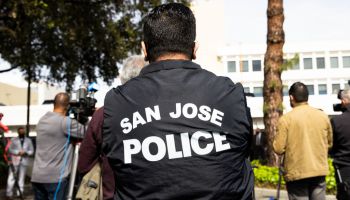
As previously reported by NewsOne, Attorney General Eric Holder recently called on a group of states to restore voting rights to ex-felons.
“Across this country today, an estimated 5.8 million Americans – 5.8 million of our fellow citizens – are prohibited from voting because of current or previous felony convictions,” he told a symposium on criminal justice at Georgetown University. “Although well over a century has passed since post-Reconstruction states used these measures to strip African-Americans of their most fundamental rights, the impact of felony disenfranchisement on modern communities of color remains both disproportionate and unacceptable.”
Holder’s comments have directed attention to the country’s long history of felony disenfranchisement. To get an idea of how far the practice goes back and how it has developed across the United States, check out this timeline via ProCon.org.
-
1100 BC – 16th Century – ‘Civil Death’ Used as Punishment for Crime in Ancient Athens, Ancient Rome, and Medieval Europe
-
1607 – 1776 – Practice of ‘Civil Death’ Is Carried over to the British Colonies in America
-
1764 – 1776 – Public Debate Ensues in the British Colonies over Whether Voting Is a Right or a Privilege
-
1789 – US Constitution Forges a Link Between Voting in National Elections and State Suffrage Rules
-
Apr. 19, 1792 – Kentucky Constitution Is First among US States to Establish Criminal Disenfranchisement
-
July 9, 1793 – Vermont Constitution Establishes Criminal Disenfranchisement
-
Nov. 29, 1802 – Ohio Constitution Establishes Criminal Disenfranchisement
-
Jan. 22, 1812 – Louisiana Constitution Establishes Criminal Disenfranchisement
-
June 10, 1816 – Indiana Constitution Establishes Criminal Disenfranchisement
-
July 7, 1817 – Mississippi Constitution Establishes Criminal Disenfranchisement
-
Oct. 12, 1818 – Connecticut Constitution Establishes Criminal Disenfranchisement
-
July 5, 1819 – Alabama Constitution Establishes Criminal Disenfranchisement
-
June 12, 1820 – Missouri Constitution Establishes Criminal Disenfranchisement
-
Aug. 28, 1821 – New York Constitution Establishes Criminal Disenfranchisement
-
Jan. 14, 1830 – Virginia Constitution Establishes Criminal Disenfranchisement
-
Nov. 8, 1831 – Delaware Constitution Establishes Criminal Disenfranchisement
-
May 1834 – Tennessee Constitution Establishes Criminal Disenfranchisement
-
Dec. 3, 1838 – Florida Constitution Establishes Criminal Disenfranchisement
-
November 5, 1842 – Rhode Island Constitution Establishes Criminal Disenfranchisement
-
June 29, 1844 – New Jersey Constitution Establishes Criminal Disenfranchisement
-
Nov. 5, 1845 – Louisiana Constitution Ratified to Bar Anyone Sentenced to Hard Labor from Voting
-
Aug. 27, 1845 – Texas Constitution Establishes Criminal Disenfranchisement
-
Aug. 3, 1846 – Iowa Constitution Establishes Criminal Disenfranchisement
-
Nov. 3, 1846 – New York Constitution Ratified to Bar Persons Convicted of “Infamous” Crimes from Voting
-
Feb. 1, 1848 – Wisconsin Constitution Establishes Criminal Disenfranchisement
-
Nov. 1849 – California Constitution Establishes Criminal Disenfranchisement
-
June 4, 1851 – Maryland Constitution Establishes Criminal Disenfranchisement
-
Aug. 29, 1857 – Minnesota Constitution Establishes Criminal Disenfranchisement
-
Nov. 1857 – Oregon Constitution Establishes Criminal Disenfranchisement
-
Feb. 3, 1870 – 15th Amendment to the US Constitution Gives the Vote to Former Slaves and Prohibits Racially Based Disenfranchisement
-
1882 – US Congress Passes the Edmunds Act, Banning Polygamists from Voting
-
1901 – New Alabama Constitution Expands Criminal Disenfranchisement in Effort to Maintain White Supremacy
-
Sep. 9, 1957 – President Eisenhower Signs the Civil Rights Act of 1957
-
Aug. 6, 1965 – President Johnson Signs the Voting Rights Act
-
May 24, 1966 – California Supreme Court in Otsuka v. Hite Defines the Term “Infamous Crimes”
-
June 13, 1967 – New York Supreme Court Rules That Criminal Disenfranchisement Is Reasonable and Constitutional in Green v. Board of Elections
-
Nov. 16, 1972 – Federal Appeals Court Argues That “Constitutional Concepts” Should Evolve Along with Modern Concepts of Justice and Punishment
-
June 24, 1974 – US Supreme Court Rules That Disenfranchising Convicted Felons Does Not Violate the Equal Protection Clause of the US Constitution
-
Nov. 5, 1974 – California Amends Constitution to Allow Felons to Vote After Completion of Incarceration and Parole
-
Apr. 22, 1980 – US Supreme Court Rules That Purposeful Racial Discrimination Must Be Evident for a Disenfranchisement Law to Be Unconstitutional
-
Apr. 16, 1985 – US Supreme Court Rules That Criminal Disenfranchisement Is Legal If there Is No Racially Discriminatory Intent
-
Nov. 4, 2000 – Massachusetts Voters Ban Incarcerated Felons from Voting
-
Mar. 15, 2001 – New Mexico Repeals Lifetime Ban on Felon Voting
-
Feb. 14, 2002 – US Senate Votes Down Amendment Granting Felons The Right to Vote in Federal Elections
-
Sep. 25, 2003 – Alabama Passes Bill Allowing Most Felons to Register to Vote
-
July 1, 2003 – Nevada Passes Bill to Automatically Restore the Vote to Felons
-
March 2005 – Nebraska Repeals Lifetime Ban on Felon Voting
-
March 2005 – Nebraska Repeals Lifetime Ban on Felon Voting
-
June 17, 2005 – Iowa Restores Vote to All Felons Who Have Completed Their Sentences
-
July 7, 2006 – Washington District Court Rules in Farrakhan v. Gregoire That State’s Criminal Disenfranchisement Laws Do Not Violate Section 2 of the Voting Rights Act
-
Apr. 5, 2007 – Florida Gov. Charlie Crist Institutes Automatic Vote Restoration to Felons Who Have Completed Their Full Sentences
-
Apr. 26, 2007 – Maryland Institutes Automatic Vote Restoration for All Felons upon Completion of Sentence
-
July 26, 2007 – Washington Supreme Court Reinstates Fine Payment as Part of Felon Re-Enfranchisement Qualifications
-
Dec. 2007 – Barack Obama Supports Felon Re-Enfranchisement
-
Jan. 5, 2010 – 9th US Circuit Court of Appeals Rules that Washington’s Felon Disenfranchisement Law Violates the Voting Rights Act
-
Oct. 7, 2010 – Washington’s Felon Disenfranchisement Law Upheld in en banc Reversal of 9th US Circuit Court Decision
-
Oct. 18, 2010 – US Supreme Court Declines Taking Up MA Felon Voting Case Simmons v. Galvin
-
Jan. 14, 2011 – Iowa Rescinds Automatic Voting Restoration for Convicted Felons Who Have Completed Their Sentences
-
Mar. 9, 2011 – Florida Rescinds Automatic Voting Restoration for Convicted Felons Who Have Completed Their Sentences
-
Mar. 19, 2012 – South Dakota Enacts HB 1247, Removing the Vote from Convicted Felons until Completion of Probation
-
Apr. 16, 2013 – Delaware Senate Passes the Hazel D. Plant Voter Restoration Act
-
May 29, 2013 – Virginia Institutes Automatic Vote Restoration to All Nonviolent Felons Who Have Completed Their Full Sentences
-
Feb. 11, 2014 – Attorney General Eric Holder Calls for Restoration of the Vote to People Convicted of a Felony
Check out more details on the timeline of felony disenfranchisement laws at ProCon.org
Timeline of Laws Barring Felons From Voting was originally published on newsone.com
















